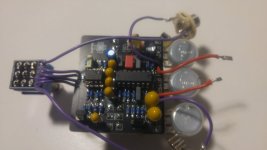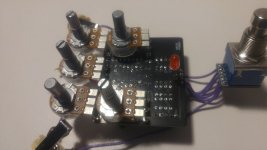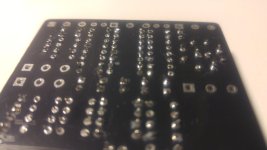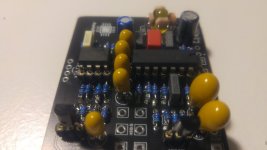Hello. I’m really new to pedal building and electronics and need some help with an Abyss pedal. I have successfully built a Cujo fuzz and decided to try the Abyss.
Symptoms are the D2 will not light up. I have sound when bypassed. When switched on, D1 lights up. At first, I thought there was no sound whatsoever, but if I turn the Level pot all the way up, I almost get to unity volume. My initial thought was that I installed D2 incorrectly, as it was not flashing. Although I was very careful to measure all resistors before installing, I did not check the polarity of D2 before installing. I plead Inexperience. I removed the pot covering access to the D2, changed the orientation of D2 and resoldered. Same results. D1 lights up, D2 does not, full Level pot gets me almost to unity. Is D2 just bad? How can I troubleshoot? Is there such a thing as a wrong value for D2?
I’m really tempted to just populate another Abyss pcb rather than deal with desoldering the Throb pot again.
I’ve attached pictures from where I populate the pcb before adding wiring and pots, as well as other pictures after I pulled the pcb from the enclosure. I was very careful to only use minimum solder, so with the wrong angle, some joints may look cold, but if you rotate the board in the light, they really are shiny. I don’t think a cold joint is the issue—I don’t think I would get continuous sound if the joints were bad. I could be absolutely wrong though.
Again, I’m new at this, and I would appreciate any help or suggestions.
Thanks,
Frank



Symptoms are the D2 will not light up. I have sound when bypassed. When switched on, D1 lights up. At first, I thought there was no sound whatsoever, but if I turn the Level pot all the way up, I almost get to unity volume. My initial thought was that I installed D2 incorrectly, as it was not flashing. Although I was very careful to measure all resistors before installing, I did not check the polarity of D2 before installing. I plead Inexperience. I removed the pot covering access to the D2, changed the orientation of D2 and resoldered. Same results. D1 lights up, D2 does not, full Level pot gets me almost to unity. Is D2 just bad? How can I troubleshoot? Is there such a thing as a wrong value for D2?
I’m really tempted to just populate another Abyss pcb rather than deal with desoldering the Throb pot again.
I’ve attached pictures from where I populate the pcb before adding wiring and pots, as well as other pictures after I pulled the pcb from the enclosure. I was very careful to only use minimum solder, so with the wrong angle, some joints may look cold, but if you rotate the board in the light, they really are shiny. I don’t think a cold joint is the issue—I don’t think I would get continuous sound if the joints were bad. I could be absolutely wrong though.
Again, I’m new at this, and I would appreciate any help or suggestions.
Thanks,
Frank





